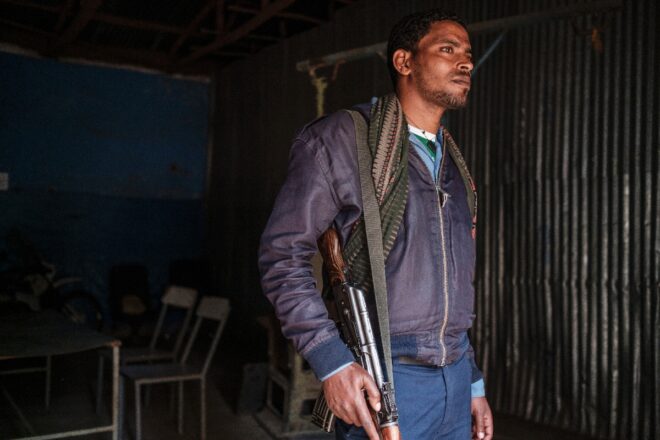The last time Ethiopian farmer Zeleke Alabachew saw combat was two decades ago, when a border war broke out with neighbouring Eritrea and he joined a ragtag militia that went to the front.
Now Zeleke is preparing to fight an enemy closer to home: the ruling party of Ethiopia’s Tigray region, where Prime Minister Abiy Ahmed last week ordered a military campaign that has Africa’s second most populous nation careening towards a potential civil war.
“In total, the militiamen in this area are around 200. We are all set and ready to go,” Zekele said, referring to his hometown of Tekeldengy in Ethiopia’s Amhara region, which borders Tigray to the south.
He spoke while standing in wheatfields with his trusty rifle — the same one he used in the Ethiopia-Eritrea war — suspended from his shoulder by a strap that read “REAL MADRID”.
Thousands of Amhara militia fighters like Zeleke have already deployed to the region’s northern border with Tigray, Mulualem Gemdhin, a regional government security adviser, told AFP.

Map of Ethiopia locating the region of Tigray© AFP Simon MALFATTO
They say their objectives are straightforward: to help federal and Amhara regional forces respond to an attack on a federal military camp by Tigray’s ruling party that Abiy described last week as the immediate catalyst for the conflict.
The once-powerful Tigray People’s Liberation Front (TPLF), which has been embroiled in a heated feud with Abiy and his government, says the attack never occurred.
Fuelling old tensions
But while the military operation that has seen air strikes, shelling and scores of soldiers wounded is not even a week old, there are already fears it could spread, inflaming old tensions between Amhara and Tigray.

Anmut Mulat is collecting money and staples from his constituents to support the Ethiopian forces© AFP EDUARDO SOTERAS
The two regions are mired in a decades-old dispute over land that has sparked violent clashes in the past and that analysts continue to see as a dangerous flashpoint.
For Melkamu Shumye, an Amhara opposition politician, the land question remains “a strategic interest” and “is in everybody’s head and heart” — especially those of militiamen now heading to the Tigray border.
That could undermine the Ethiopian military’s stated goal of keeping the fighting contained to Tigray, as well as diplomats’ frantic efforts to bring the conflict to a swift end altogether.

Gondar is the largest city northern Amhara© AFP EDUARDO SOTERAS
“Any involvement of Amhara regular and irregular forces in the conflict in west Tigray means it is likely some of them will try and reclaim territory in that area,” said William Davison of the International Crisis Group (ICG).
“This would deepen the conflict, lead to fighting between Tigray and Amhara elements, and make it less likely that the TPLF would agree to a ceasefire.”
‘Criminal cliques’
The TPLF came to power in 1991 after toppling Mengistu Hailemariam, chairman of the brutal communist Derg regime.
As the ICG noted in a report last June, the Tigray-Amhara land dispute “came into focus” that same year, when the Tigrayans allegedly annexed land that, in the eyes of the Amharas, was rightfully theirs.

People donate blood in the Ethipian city of Gondar to help special forces in the Amhara region© AFP EDUARDO SOTERAS
The disputed land mostly falls in western Tigray, where much of the past week’s fighting has unfolded.
In Amhara, lingering grievances over this perceived injustice helped fuel anti-government protests that swept Abiy to the premiership in 2018.
Even with the TPLF now sidelined from power under Abiy, tensions over the land remain unresolved.
Over the past week in Gondar, the largest city in northern Amhara, residents have found a variety of ways to support forces taking the fight to the TPLF.
Anmut Mulat, head of one of the city’s sub-districts, immediately started collecting money and Ethiopian staples — injera flatbread and powder to make shiro stew — from his constituents, most of whom contributed without being asked.
Standing beside a table where donated injera was drying out in the sun, he told AFP he fully supported the government’s stated goal of “liberating” Tigray from its ruling party.
“Our goal is to bring to justice the criminal cliques, the people who we call criminals who are currently leading in Tigray,” Anmut said.
-‘Our brothers and sisters’-
Anmut stressed, though, that his animosity did not extend to the Tigrayan population as a whole.
“Our societies are integrated. We’ve been living together for a very long time. You can’t separate us,” he said.
Abiy has taken a similar line, railing against the TPLF while insisting in a Twitter post Sunday that Tigrayans writ large should not be discriminated against.
Such sentiments have also been on display at blood-donation tents that have popped up in Gondar.
However some residents made clear they saw their donations as a contribution to just one side of the war effort.
“This regional government victimised so many Ethiopians for the last 27 years,” said Asebe Assefa, a 29-year-old banker, referring to the TPLF.
“The people want revenge,” he added.

Policeman Sajin Misganaw Yonannes says the ‘Tigray people are our brothers’© AFP EDUARDO SOTERAS
Others said they just wanted to reduce fatalities resulting from the fighting, and that they’d be equally happy if their blood saved the life of an Amhara or a Tigrayan combatant.
“The Tigray people are our brothers and sisters, also our fathers and mothers,” said police officer Sajin Misganaw Yohannes.
Source: 24 Matins UK































